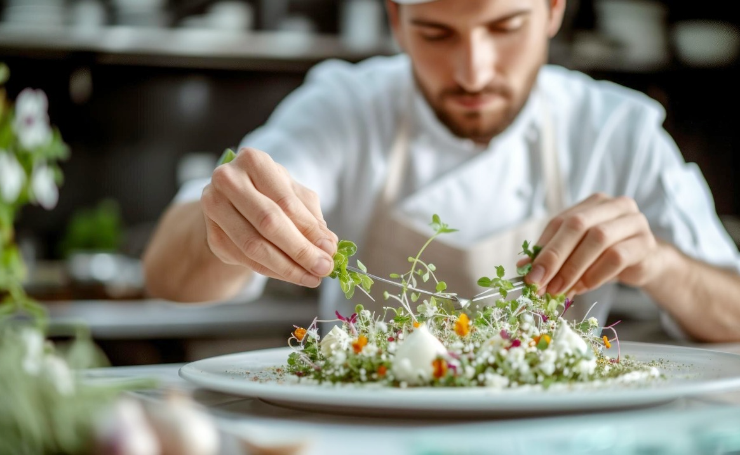Fine dining has always been about more than just food—it’s an immersive experience that combines artistry, innovation, and exclusivity. As the world evolves, so too does haute cuisine. In recent years, chefs and restaurateurs have embraced cutting-edge techniques, sustainable practices, and multisensory elements to create a new era of luxury dining. Here are the key trends shaping the future of haute cuisine.
Sustainability and Ethical Sourcing

Luxury dining is no longer just about rare ingredients; it’s about responsible sourcing and sustainability. Michelin-starred restaurants are prioritizing seasonal, locally grown produce and ethically sourced seafood and meats. Zero-waste kitchens, where every part of an ingredient is utilized, are becoming the gold standard. Restaurants like Copenhagen’s Noma and London’s Silo have pioneered this movement, proving that sustainability can coexist with refinement.
Another rising trend is regenerative farming, where chefs partner with farmers who focus on soil health and biodiversity, ensuring long-term sustainability. Fine dining establishments are also increasingly transparent about their supply chains, educating diners on the origins of their meals.
The Rise of Plant-Based and Lab-Grown Cuisine

As global dietary preferences shift, haute cuisine is adapting. Luxury restaurants are moving beyond traditional vegetarian menus, crafting plant-based dishes with the same complexity and depth as meat-based offerings. Ingredients like jackfruit, seaweed, and heirloom legumes are now central to high-end dishes.
Moreover, lab-grown meat and seafood are making their way into fine dining. These innovations provide a cruelty-free alternative while maintaining the taste and texture of premium proteins. Forward-thinking chefs are experimenting with cultured wagyu beef, caviar, and bluefin tuna, ensuring that the luxury of haute cuisine remains intact while reducing environmental impact.
The Integration of Technology in Fine Dining

Technology is revolutionizing fine dining, creating a more immersive and interactive experience. AI-powered kitchens optimize ingredient usage, reducing waste while maintaining precision in plating and flavor. Augmented reality (AR) and virtual reality (VR) are also being incorporated into dining experiences, allowing guests to be transported to vineyards, farms, or even space while enjoying their meal.
Another notable innovation is 3D food printing, which enables chefs to craft intricate designs and textures that were previously impossible by hand. Some high-end restaurants use this technology to create unique edible sculptures or delicate, lace-like garnishes.
Hyper-Personalization and Bespoke Menus

Exclusivity has always been at the heart of haute cuisine, and today’s fine dining is taking personalization to a new level. Luxury restaurants are moving beyond standard tasting menus, offering customized dining experiences based on guests’ preferences, dietary needs, and even genetic data.
Some establishments use AI-driven analysis of guests’ previous orders, allergies, and flavor preferences to curate one-of-a-kind meals. In ultra-exclusive settings, chefs are crafting multi-course experiences tailored to individual palates, ensuring that no two dining experiences are ever the same.
The Evolution of Minimalist Luxury

While haute cuisine was once defined by excess, today’s luxury is often about refined simplicity. Top restaurants are focusing on purity of flavor rather than overcomplicated dishes. A single, perfectly prepared ingredient—whether an aged soy sauce, a heritage tomato, or a dry-aged fish—can now be the star of a dish.
This shift is also reflected in restaurant design. Gone are the days of opulent chandeliers and gold-plated décor; instead, fine dining spaces embrace Japanese-inspired minimalism, natural materials, and intimate atmospheres that allow the food to take center stage.
Multi-Sensory and Experiential Dining

Haute cuisine is becoming an immersive experience that engages all five senses. Restaurants like Ultraviolet in Shanghai and Sublimotion in Ibiza are blending food with sound, lighting, temperature changes, and even scent diffusions to elevate the dining experience.
Some chefs are also incorporating interactive elements, such as edible tableware, live cooking performances, and customized music pairings designed to enhance specific flavor profiles. This trend is about making luxury dining not just a meal, but a theatrical event that stays with diners long after the last bite.
The future of haute cuisine is a balance between tradition and innovation, where sustainability meets exclusivity, and technology enhances the artistry of cooking. Fine dining is no longer just about indulgence; it’s about creating a meaningful, unforgettable experience that resonates with modern diners. As chefs continue to push boundaries, haute cuisine will remain at the forefront of culinary evolution, redefining luxury in bold and unexpected ways.



